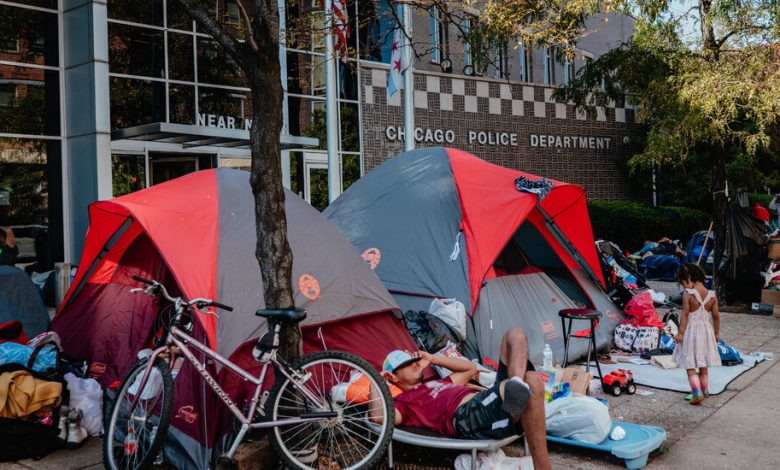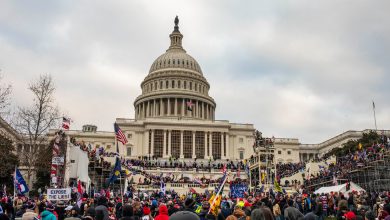As Winter Looms, Venezuelan Migrant Surge Overwhelms Chicago

The buses packed with Venezuelan migrants are now arriving in downtown Chicago day and night, doubling in number in recent weeks. City officials are struggling to open more shelters, while more than 2,300 migrants are sleeping at police stations, in lobbies and just outside in makeshift camps.
At the city’s airports, migrants who have just landed sleep on the floor, many with babies and toddlers, as local officials plead for more help from the federal government.
“We don’t have any place for them to go,” said Cristina Pacione-Zayas, deputy chief of staff for Mayor Brandon Johnson. “We are scrambling.”
Like New York and a number of other cities in the country, Chicago is straining to provide for the growing numbers of migrants who have arrived over the last year on buses from the U.S.-Mexico border. But with Chicago’s infamously cold winter fast approaching, volunteers and leaders are worried that things will only get worse.
The situation is putting new pressure on Mr. Johnson, who took office in May.
Mr. Johnson, a Democrat, said this week that he intended to travel with a city delegation to the border, where they would gather information about the flow of migrants.

A young Venezuelan boy rode his bike in front of the Inn of Chicago, where more than 400 asylum seekers are being housed.Credit…Jamie Kelter Davis for The New York Times
The crisis has caused clashes in the Chicago City Council, whose members have fought over how much to spend on the asylum seekers amid other pressing priorities in the city of 2.7 million people.
“It’s a logistical nightmare,” said Andre Vasquez, the chairman of the city’s Committee on Immigrant and Refugee Rights. “You’re going to see more people on the street figuring out a way to survive.”
Volunteers have worked to help the asylum seekers in the spirit of Chicago’s tradition as a sanctuary city for immigrants. But in some neighborhoods, there has been growing resistance. Public meetings to discuss opening shelters have turned into shouting matches, with residents accusing city officials of prioritizing the needs of new arrivals over longtime Chicagoans.
Some residents feel the city has been too accommodating. Deaundre Miguel Jones, 47, said he had watched with exasperation as the police station in his Old Town neighborhood turned into a place where migrants sleep on cots indoors and outside in camping tents.
“These people are eating well — they have better phones than I do, better shoes,” Mr. Jones said, sitting outside his apartment complex. Chicago officials, he said, are doing more to help migrants than they are people who have lived in the city for years.
“How are you going to take care of someone else when you’re not even taking care of your own people?” he said.
What has drawn the migrants to Chicago is not always clear. Some eagerly boarded buses to Chicago at the southern border because they recognized the name of the city and assumed that it was large enough to offer opportunity and a place to work. Officials in Chicago pointed to Gov. Greg Abbott of Texas, a Republican, for his campaign to bus migrants to liberal cities out of political motivation, but some migrants arrive in those cities on trips paid for by charities, volunteer groups or family members.
In interviews, several Venezuelans who had arrived recently said they had come to Chicago because they had distant relatives in the city or had heard from friends that it had robust social services. But many said Chicago had become their destination simply because they were offered a free plane or bus ticket from previous shelters, where they arrived penniless and sleep deprived.
“We came here with one sole purpose: to work,” said Eudo Luis Ledezma, 41, who arrived in Chicago on Tuesday after a harrowing two-month journey that began in his hometown, Maracaibo, a city in northwestern Venezuela. “We were tired of living in misery.”
Many newly arrived Venezuelans said they had found their way to Chicago after stops in San Antonio and Denver, where shelters were teeming with people.
Yureibi Olivo, a mother of four who arrived in Chicago this summer, said she was already glad her family had taken the great risk to leave. She is among the lucky few who secured beds at a temporary shelter in a downtown hotel.
Ms. Olivo, 45, has been selling arepas, stuffed cornmeal cakes, on the streets, where she pulls in around $60 a day. Back home, working two jobs — one as a street sweeper and one preparing government-subsidized meals — would earn her that amount in three months, she said.
“Being here is a privilege,” Ms. Olivo said. “God gave us an opportunity, and the government here has opened the door.”
Gov. J.B. Pritzker of Illinois, a Democrat, has offered resources and financial support from the state. Since August 2022, his administration has allocated $328 million in aid, according to a spokeswoman.
But it is not nearly enough, city officials say. Chicago leaders signed a $29 million contract last month that calls for the sheltering of migrants in winterized tents. And the overall cost of housing and feeding the migrants is skyrocketing: The city is expected to spend at least $345 million in less than a year and a half, according to city officials. (The Chicago Public Schools, for comparison, have an annual budget of more than $9 billion.)
Mr. Pritzker, in a letter to President Biden this week, said that more aid from the federal government was urgently needed.
Currently, more than 10,000 migrants are in shelters, according to city data. Close to 3,200 are staying at police stations and airports.
Erika Villegas, a volunteer who is aiding migrants at police stations, said that she was concerned about the migrants’ ability to withstand the colder weather that was coming, especially since many were sleeping outdoors in tents.
“For Chicagoans, this is beautiful weather,” she said. “But for the new families, they’re asking for jackets. People are like: ‘I couldn’t sleep all night. My toes were cold all night.’ They have no idea what’s coming.”
On the Far South Side, Anthony Beale, a City Council member, said that the situation had become a disaster and an embarrassment, especially when considering the role of the federal government.
“The solution, No. 1, is for Joe Biden to close the border,” he said. “Secondly, what we need to do is disperse the migrants across the country evenly, and not just send them to certain cities or certain states. Everybody should be helping out with this crisis.”
Volunteers in Chicago, who have been working for more than a year to help migrants at police stations with food, clothing, tents, medical care and public school registrations, said that they had recently been more overwhelmed than at any point since migrants began arriving in summer 2022.
“We’re in a new phase just in this last week,” said Annie Gomberg, the lead volunteer organizer for a police station on the West Side. “We are reaching capacity in a way that makes everyone uneasy. The mayor’s office really seems overmatched by this problem.”
Ms. Gomberg saw the arrivals as an opportunity in the long term.
In the Austin neighborhood on the West Side, there are plenty of empty apartments, she said, adding that she had already encouraged one landlord to rent to the new arrivals.
“I said, ‘If you rent to these folks, this could be the revitalization of a blighted part of Black Chicago — you could be the mayor of Little Caracas,” she said. “This could be the next wave of immigrants, who have always been the bedrock of Chicago.”





